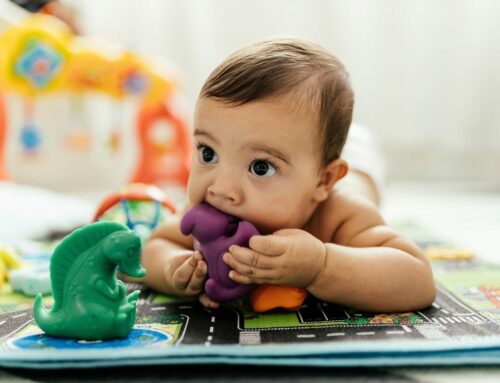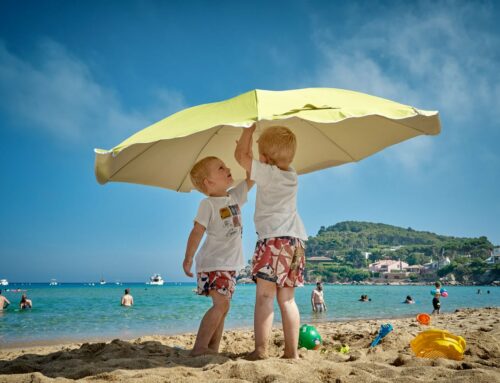Summer Safety Tips: Staying Safe Outdoors
Keep your family safe this summer by following these tips from the American Academy of Pediatrics (AAP). Also, see Summer Safety Tips: Sun and Water Safety for more information.
Fireworks Safety
- Fireworks that are often thought to be safe, such as sparklers, can reach temperatures above 1000 degrees Fahrenheit, and can burn users and bystanders.
- Families should attend community fireworks displays run by professionals rather than using fireworks at home.
- The AAP recommends prohibiting public sale of all fireworks, including those by mail or the Internet.
BUG SAFETY
- Don’t use scented soaps, perfumes or hair sprays on your child.
- Avoid areas where insects nest or congregate, such as stagnant pools of water, uncovered foods and gardens where flowers are in bloom.
- If possible, eliminate stagnant water, such as in bird baths or fish ponds, in your yard. Dump any buckets or tires that may contain standing water. Check that your window screens are tightly fitted and repair any holes to keep bugs out of the house.
- Avoid dressing your child in clothing with bright colors or flowery prints.
- To remove a visible stinger from skin, gently back it out by scraping it with a credit card or your fingernail.
- Combination sunscreen/insect repellent products should be avoided because the sunscreen needs to be reapplied every two hours, but the insect repellent should not be reapplied that often.
- Use insect repellents containing DEET when needed to prevent insect-related diseases. Ticks can transmit Lyme Disease, and mosquitoes can transmit West Nile, Zika virus, Chikungunya virus and other viruses.
- The current AAP and CDC recommendation for children older than 2 months of age is to use 10% to 30% DEET. DEET should not be used on children younger than 2 months of age.
- The effectiveness is similar for 10% to 30% DEET but the duration of effect varies. Ten percent DEET provides protection for about 2 hours, and 30% protects for about 5 hours. Choose the lowest concentration that will provide the required length of protection.
- The concentration of DEET varies significantly from product to product, so read the label of any product you purchase. Children should wash off repellents when they return indoors.
- As an alternative to DEET, picaridin has become available in the U.S. in concentrations of 5% to10%.
- When outside in the evenings or other times when there are a lot of mosquitoes present, cover up with long sleeved shirts, pants and socks to prevent bites.
- Children should wear hats to protect against ticks when walking in the woods, high grasses or bushes. Check hair and skin for ticks at the end of the day.
Playground Safety
- The playground should have safety-tested mats or loose-fill materials (shredded rubber, sand, wood chips, or bark) maintained to a depth of at least 9 inches (6 inches for shredded rubber). The protective surface should be installed at least 6 feet (more for swings and slides) in all directions from the equipment.
- Equipment should be carefully maintained. Open “S” hooks or protruding bolt ends can be hazardous.
- Swing seats should be made of soft materials such as rubber, plastic or canvas.
- Make sure children cannot reach any moving parts that might pinch or trap any body part.
- Never attach—or allow children to attach—ropes, jump ropes, leashes, or similar items to play equipment; children can strangle on these. If you see something tied to the playground, remove it or call the playground operator to remove it.
- Make sure your children remove helmets and anything looped around their necks.
- Metal, rubber and plastic products can get very hot in the summer, especially under direct sun.
- Make sure slides are cool to prevent children’s legs from getting burned.
- Do not allow children to play barefoot on the playground.
- Parents should supervise children on play equipment.
- Parents should never purchase a home trampoline or allow children to use a home trampoline because of the risk of serious injury even when supervised.
- Surrounding trampoline netting offers a false sense of security and does not prevent many trampoline-related injuries. Most injuries happen on the trampoline, not from falling off.
- If children are jumping on a trampoline, they should be supervised by a responsible adult, and only one child should be on the trampoline at a time; 75% of trampoline injuries occur when more than one person is jumping at a time.
- Homeowners should verify that their insurance policies cover trampoline-related claims. Coverage is highly variable and a rider may need to be obtained.
Bicycle Safety
- A helmet protects your child from serious injury, and should always be worn. And remember, wearing a helmet at all times helps children develop the helmet habit.
- When purchasing a helmet, look for a label or sticker that says the helmet meets the CPSC safety standard.
- A helmet should be worn so that it is level on the head and covers the forehead, not tipped forward or backwards. The strap should be securely fastened with about 2 fingers able to fit between chin and strap. The helmet should be snug on the head, but not overly tight. Skin should move with the helmet when moved side to side. If needed, the helmet’s sizing pads can help improve the fit.
- Do not push your child to ride a 2-wheeled bike without training wheels until he or she is ready. Consider your child’s coordination and desire to learn to ride. Stick with coaster (foot) brakes until your child is older and more experienced for hand brakes. Consider a balance bike with no pedals for young children to learn riding skills.
- Take your child with you when you shop for the bike, so that he or she can try it out. The value of a properly fitted bike far outweighs the value of surprising your child with a new one. Buy a bike that is the right size, not one your child has to “grow into.” Oversized bikes are especially dangerous.
- Your child should ride on the right, facing the same direction as traffic, and should be taught to obey all stop signs and other traffic control devices. Children should never ride at night.
Skateboard, Scooter, In-Line Skating and Heelys Safety
- All skateboarders and scooter-riders should wear protective gear; helmets are particularly important for preventing and minimizing head injuries. Riders should wear helmets that meet ASTM or other approved safety standards, and that are specifically designed to reduce the effects of skating hazards.
- Communities should continue to develop skateboard parks, which are more likely to be monitored for safety than ramps and jumps constructed by children at home.
- While in-line skating or using Heelys, only skate on designated paths or rinks and not in the street.
- Most injuries occur due to falls. Inexperienced riders should only ride as fast as they can comfortably slow down and maintain control. They should practice falling on grass or other soft surfaces. Before riding, skateboarders should survey the riding terrain for obstacles such as potholes, rocks, or any debris. Protective wrist, elbow and kneepads should be worn.
- Children should never ride skateboards or scooters in or near moving traffic.
- Children should never skate alone. Children under the age of eight should be closely supervised at all times.
All-terrain Vehicles
- Children who are too young to have a driver’s license should not be allowed to operate or ride off-road vehicles. Children are involved in about 30 percent of all ATV-related deaths and emergency room-treated injuries.
- Because their nervous systems and judgment have not fully developed, off-road vehicles are particularly dangerous for children younger than 16 years.
- Don’t ride double. Passengers are frequently injured when riding ATVs. Most ATVs are designed to carry only one person: the driver. Passengers can make ATVs unstable and difficult to control.
- All ATV riders should take a hands-on safety training course.
- All riders should wear helmets, eye protection, sturdy shoes (no flip-flops), and protective, reflective clothing. Appropriate helmets are those designed for motorcycle (not bicycle) use, and should include safety visors/face shields for eye protection. Wearing a helmet may prevent or reduce the severity of injuries.
- ATVs lack the common safety equipment found on all cars and trucks that are designed for street use. ATV tires are not designed to grip on pavement, so operators should not ride on paved roads. Parents should never permit nighttime riding or street use of off-road vehicles.
- Flags, reflectors and lights should be used to make vehicles more visible.
- Drivers of recreational vehicles should not drive while under the influence of alcohol, drugs or even some prescription medicines. Parents should set an example for their children in this regard.
- Young drivers should be discouraged from on-road riding of any 2-wheeled motorized cycle, even when they are licensed to do so, because they are inherently more dangerous than passenger cars.
Lawn Mower Safety
- Only use a mower with a control that stops the mower blade from moving if the handle is let go.
- Children younger than 16 years should not be allowed to use ride-on mowers. Children younger than 12 years should not use walk-behind mowers.
- Make sure that sturdy shoes are worn while mowing.
- Prevent injuries from flying objects, such as stones or toys, by picking up objects from the lawn before mowing begins. Have anyone who uses a mower wear hearing and eye protection.
- Do not pull the mower backward or mow in reverse unless absolutely necessary, and carefully look for children behind you when you mow in reverse.
- Always turn off the mower and wait for the blades to stop completely before removing the grass catcher, unclogging the discharge chute, or crossing gravel paths, roads, or other areas.
- Do not allow children to ride as passengers on ride-on mowers.
- Keep children out of the yard while mowing.
- Drive up and down slopes, not across to prevent mower rollover.
- Keep guards, shields, switches, and safety devices in proper working order at all times.
- If children must be in the vicinity of running lawnmowers, they should wear polycarbonate protective eye wear at all times.








